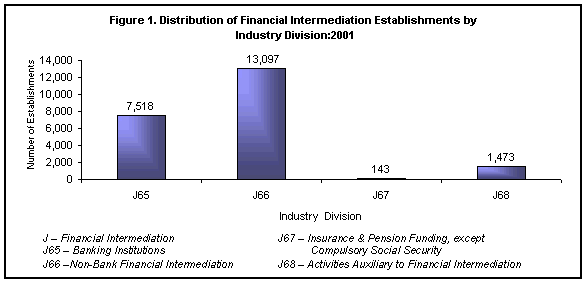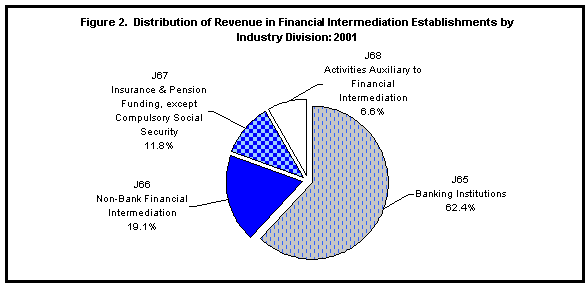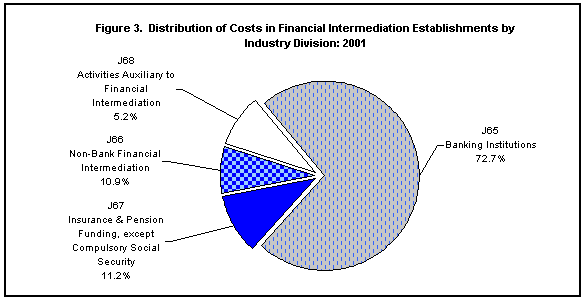Non-Bank Financial Intermediation dominated Financial Intermediation Sector
-
The 2002 Annual Survey of Philippine Business and Industry covered a total of 22,231 Financial Intermediation establishments. Of the total figure, 21,037 establishment or 94.6 percent were with average total employment (ATE) of less than 20. The remaining 1,194 establishments or 5.4 percent were with average total employment of 20 and over.
-
By industry division, Non-bank Financial Intermediation (PSIC J66) registered the highest number of establishments which comprised of 13,097. This accounted for more than one-half (58.9%) of the total financial intermediation establishments. Banking Institutions (PSIC J65) followed next with 7,518 establishments (33.8%) while Activities Auxiliary to Financial Intermediation (PSIC J68) ranked third with 1,473 establishments (6.6%). On the other hand, establishments engaged in Insurance and Pension Funding except Compulsory Social Security (PSIC J67) recorded the least in number of establishments with 143 or 0.6 percent. Figure 1 shows the distribution of establishments by industry division

Financial intermediation establishments employed 231,434 workers in 2001
-
Financial Intermediation establishments generated jobs for an estimated 231,434 workers. Of the total work force, 220,599 (95.3%) were paid employees and 10,835 (4.7%) were working owners and unpaid workers.
-
Banking Institutions (PSIC J65) were the top employers in the sector which employed 133,291 workers or more than half (57.6%) of the total employment. Non-bank Financial Intermediation (PSIC J66) establishments followed next with 66,804 workers (28.9%). In contrast, Insurance and Pension Funding, except Compulsory Social Security (PSIC J67) recorded the least number of workers with 11,392 persons (4.9%).
Banking institutions employees received highest pay in Financial Intermediation establishments
-
Compensation paid to employees by financial intermediation establishments amounted to P53.61 billion in 2001 or equivalent to an average annual remuneration of P243,028 thousands
-
Industrywise, Banking Institutions (PSIC J65) paid the highest to its employees with an estimated amount of P38.37 billion, accounting for almost three-fourths (71.6%) of the total compensation. This was followed by Non-bank Financial Intermediation (PSIC J66) with P7.87 billion (14.7%). On the other hand, Insurance and Pension Funding, except Compulsory Social Security (PSIC J67) paid the least to its employees with P3.66 billion (6.8%).
-
Highest earners were employees in Insurance and Pension Funding, except Compulsory Social Security (PSIC J67) with an average monthly pay of P26,843. This was closely followed by workers in Banking Institutions (PSIC J65) with P24,049 monthly pay. Meanwhile, workers in Non-bank Financial Intermediation (PSIC J66) establishments received the lowest average monthly pay of P11,389. (See Table R. Selected Ratios for All Financial Intermediation Establishments by Industry Division).
Total revenue earned amounted to P553.14 billion
-
The total revenue generated by the sector in 2001 reached P553.14 billion.
-
Among the industry divisions, Banking Institutions (PSIC J65) earned the highest with P345.40 billion or accounting for almost two thirds (62.4%) of the total revenue. Non-bank Financial Intermediation (PSIC J66) placed second which generated P105.64 billion (19.1%) and Insurance and Pension Funding, except Compulsory Social Security (PSIC J67) ranked third with P65.43 billion (11.8%). In contrast, Activities Auxiliary to Financial Intermediation (PSIC J68) received the least income representing P36.67 billion (6.6%). Figure 2 shows the distribution of revenue by industry division.

Operational cost totaled to P 441.53 billion
-
In 2001, the operational costs spent by Financial Intermediation establishments stood at P441.53 billion.
-
The biggest spender in the sector was Banking Institutions (PSIC J65) which incurred P321.11 billion or 72.7 percent of the total costs. This was followed by Insurance and Pension Funding, except Compulsory Social Security (PSIC J67) and Non-bank Financial Intermediation (PSIC J66) with P49.36 billion (11.2%) and 47.99 billion (10.9%), respectively. Whereas, Activities Auxiliary to Financial Intermediation (PSIC J68) spent the least with P23.08 billion (5.2%). Figure 3 shows the distribution of costs by industry division.

Revenue per peso cost was valued at P1.25
-
The revenue per peso cost by Financial Intermediation establishments was estimated at 1.25. This was interpreted as for every peso spent by the industry, a corresponding value of P1.25 was generated.
-
Three industries in the sector surpassed the national level rate, these were: Non-Bank Financial Intermediation (PSIC J66) with P2.20, Activities Auxiliary to Financial Intermediation (PSIC J68) with P1.59 and Insurance and Pension Funding, except Compulsory Social Security (PSIC J67) with P1.33. (See Table R1. Selected Ratios for All Financial Intermediation Establishments).
Total gross additions to fixed assets amounted to P 11.10 billion
-
Total gross additions to fixed assets acquired by financial intermediation establishments was assessed at P11.10 billion in 2001.
-
By industry division, Banking Institutions (PSIC J65) recorded the largest in gross additions to fixed assets amounting to P4.85 billion or 43.7 percent of the total. This was followed by Non-Bank Financial Intermediation (PSIC J66) with an added value to fixed assets worth of P2.68 billion (24.1%). However, Activities Auxiliary to Financial Intermediation (J68) posted the least in gross additions to fixed assets amounting to P1.49 billion (13.5%).
Total change in inventories resulted to a negative value of P13.07 million
-
From the inventory reports of financial intermediation establishments, change in the inventories resulted to a negative value of P13.07 million in 2001. Only Non-bank Financial Intermediation (PSIC J66) registered a positive change in total inventories amounting to P6.96 million in 2001. The rest of the industry divisions reported negative change in inventories.
Value added generated in year 2001 reached P167.96 billion
-
The total value added generated by Financial Intermediation establishments was estimated at P167.96 billion.
-
By industry divisions, Non-Bank Financial Intermediation (PSIC J66) registered the highest value added with P66.09 billion or 39.3 percent of the total. Banking Institutions (PSIC J65) closely followed with P58.81 billion (35.0%) while establishment engaged in Insurance and Pension Funding, except Compulsory Social Security (PSIC J67) ranked third with P22.98 billion (13.7%). Activities Auxiliary to Financial Intermediation (PSIC J68) shared the least to total value added with P20.07 million (12.0%).
Subsidies provided by government amounted to P 774.50 million
-
The total subsidies granted by government to support the operation of financial intermediation establishments reached P774.50 million.
-
Industrywise, Non-bank Financial Intermediation (PSIC J66) and Banking Institutions (PSIC J65) received subsidies from the government amounting to P554.06 million (71.5%) and P220.44 million (28.5%), respectively.
TECHNICAL NOTES:
Scope and Coverage:
The 2002 Annual Survey of Philippine Business and Industry (ASPBI) formerly known as Annual Survey of Establishments (ASE) was conducted to collect information on the structure and trends of economic activities in the entire country for the year 2001. Covered were establishments engaged in economic activities as defined under the 1994 Philippine Standard Industrial Classification (PSIC).
These establishments were classified into 14 sectors, one of which was on Financial Intermediation (Sector J). The sector is composed of establishments engaged in four industry divisions, namely: banking institution (J65); non-bank financial intermediation (J66); insurance and pension funding, except compulsory social security (J67) and activities auxiliary to financial intermediation (J68).
All financial intermediation establishments nationwide with average total employment (ATE) of 100 and over were covered on a 100 percent basis and those with ATE less than 100 were selected using simple random sampling.
Response Rate
A total of 882 or 89.36% responded out of the 987 samples drawn for the sector. Adjustments for non-response were made through imputations.
Concepts and Definitions of Terms
Establishments - is an economic unit, which engages under a single ownership or control, i.e. under a single legal entity, in one, or predominantly one kind of economic activity at a single fixed location.
Economic Activity - or business is the activity of the establishment as classified under the1994 Philippine Standard Industrial Classification (PSIC). The main activity refers to the activity that contributes the biggest or major portion of the gross income or revenue of the establishment.
Employment - is the number of persons who worked in or for the establishment as of November 15, 2001.
Paid Employees - are all persons working in the establishments receiving pay as well as those working away from the establishment when paid by and under the control of the establishment. Included are persons working as full-time or part-time and those employees on sick leave or maternity leave, paid vacation or holiday. Excluded are consultants, home workers and workers receiving commission only.
Unpaid Workers - include working owners who do not receive regular pay, apprentices and learners without regular pay, and persons working without regular pay for at least one third of the working time normal to the establishment.
Salaries and Wages - are payments in cash or in kind, prior to deduction for employee's contribution to SSS/GSIS, withholding tax, etc. Included are total basic pay, vacation, sick, maternity leave pay, overtime pay, and other benefits.
Revenue - refers to cash received and receivables for goods sold and services rendered.
Costs - refers to all expenses excluding compensation incurred during the year whether paid or payable. Valuation should be at market price including taxes and other charges, net of discounts, rebates, returns and allowances. Goods received from and services rendered by other establishment of the same enterprise are valued as though purchased
Gross Addition to Fixed Assets - refer to the cost of acquisition of fixed assets acquired in 2001 less the value of sales of fixed assets during the year.
Fixed Assets - are physical assets expected to have productive life of more than one year and intended for use and/or being used by the establishment. Included are land, buildings, fixtures, machinery, tool, furniture, office equipment, vehicles, and the like.
Capital expenditures - refer to the cost of acquisition of fixed assets acquired in 2001 whether or not full payments have been made.
Subsidies - are special grants in the form of financial assistance or tax exemption or tax privilege given by the government to develop an industry or production and to protect it against competition.
Inventories - refer to stocks of goods owned by or under the control of the establishment as of a fixed date, regardless of where the stocks are located. Valuation should be at current replacement cost in purchaser's price at the indicated dates. Replacement cost is the cost of an item in terms of its present price rather than its original price.
Change in Inventories - as a derived indicator is computed as the value of ending inventory less the value of beginning inventory.
Value added - is equal to the sum of total revenue and cost of fixed assets produced on own account less the following items - cost of materials and supplies purchased; cost of fuels, lubricants, oils and greases purchased; cost of electricity and water purchased; cost of industrial services done by others; cost of non-industrial services done by others; cost of goods purchased for resale; cost of research and experimental development activity; insurance claims (for insurance companies) and other costs (except indirect taxes for banking institutions and financial intermediaries; and indirect taxes and interest expense for insurance); this result being corrected for change in inventories.
Source: National Statistics Office
Manila, Philippines
